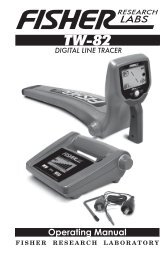Quick Start - Nexcesscdn.net
Quick Start - Nexcesscdn.net
Quick Start - Nexcesscdn.net
Create successful ePaper yourself
Turn your PDF publications into a flip-book with our unique Google optimized e-Paper software.
18 Turning the<br />
Detector On<br />
Detecting Basics<br />
19<br />
The POWER button turns the detector<br />
on and off.<br />
The Explorer SE has factory preset<br />
settings that have been chosen to suit<br />
first-time detectorists. The detector will<br />
respond to some targets (low-ferrous<br />
metal objects such as silver coins and<br />
jewelry) and ignore others (high-ferrous<br />
objects such as nails).<br />
It is best to only turn the detector on<br />
when outdoors, away from sources of<br />
electromag<strong>net</strong>ic disturbance such as<br />
power lines and phone towers. These<br />
sources may cause the detector to<br />
perform erratically, giving numerous<br />
false signals.<br />
There are also many metallic objects<br />
inside a house such as nails in the floor,<br />
reinforcing in the walls, televisions and<br />
other household appliances that might<br />
overload the electronics of the detector.<br />
Press and hold<br />
Press and Release<br />
To turn the detector on with Factory<br />
Preset settings:<br />
Press and hold POWER for 2 seconds.<br />
‘FACTORY PRESETS’ will appear briefly on<br />
the start-up display.<br />
Turning the detector on with factory<br />
presets will restore all settings and the<br />
Discrimination Pattern.<br />
To turn the detector on with the<br />
previous settings:<br />
Press and release POWER. This will start<br />
the detector with the previous display<br />
and settings from when the detector was<br />
last used (eg. Sensitivity, Volume, etc.)<br />
During the start up display, a four-note<br />
tune will sound.<br />
Sometimes it is possible that a large object close<br />
to the coil will overload the detector’s electronics.<br />
When this happens, the Explorer SE emits a low<br />
‘warble’ which will repeat until the coil is moved<br />
away from the source of the overload.<br />
Overloading is not harmful to<br />
the electronics of the detector.<br />
Targets<br />
Buried metal objects are referred to as<br />
targets. Targets are comprised of ferrous<br />
and non-ferrous metals. High-ferrous<br />
metals are those that contain iron such<br />
as steel, nails and some types of coins.<br />
Low-ferrous metals are those that have<br />
no iron content, such as gold, silver,<br />
copper, bronze and aluminium.<br />
You may wish to find a range of both<br />
low and high ferrous targets.<br />
Examples of common targets:<br />
Desired high-ferrous target - Canadian coin<br />
Undesired high- ferrous target - iron nail<br />
Desired low-ferrous target - gold coin<br />
Undesired low-ferrous target - pull-tab<br />
Sweeping the Coil<br />
The Explorer SE will perform at its best<br />
when the coil is kept close and parallel<br />
to the ground at all times. This will<br />
increase detection depth and response<br />
to small objects. Avoid excessive<br />
brushing of the coil on the ground,<br />
as this may result in false signals and<br />
inaccurate Target ID’s.<br />
Practise sweeping the coil over the<br />
ground in a side-to-side motion, while<br />
walking forward slowly at the end<br />
of each sweep. Slightly overlap the<br />
previous sweep to ensure full ground<br />
coverage. An average sweep speed is<br />
four seconds from left to right to left.<br />
A variation in coil height at the end of<br />
each swing may also cause confusing<br />
sounds and reduce detection depth.



